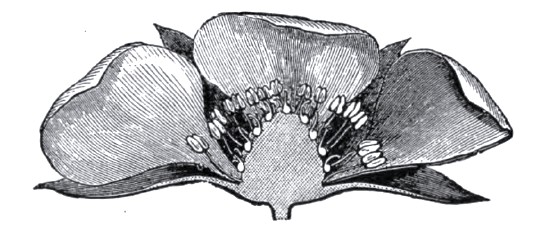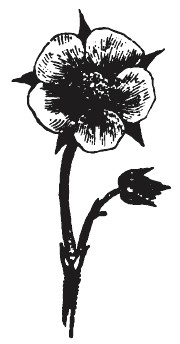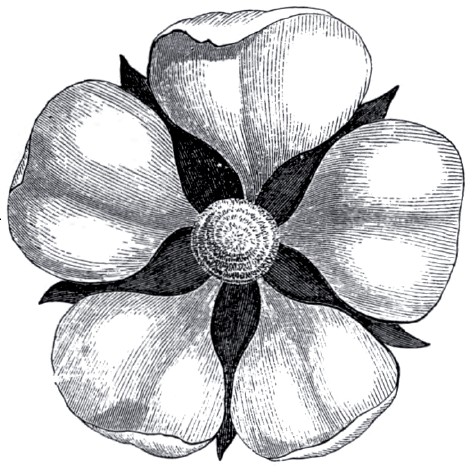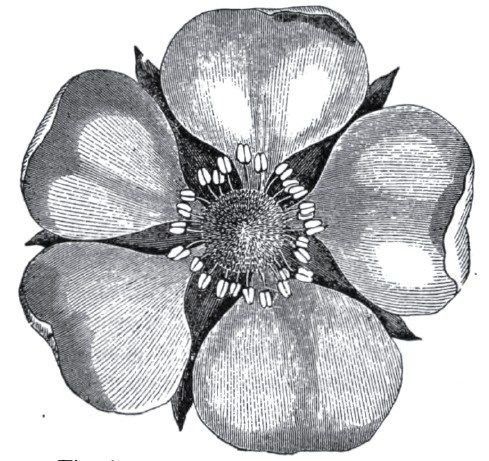| THE
STRAWBERRY.
A
genus of low perennial stemless herbs with runners, and leaves
divided into three leaflets; calyx open and flat; petals five, white;
stamens ten to twenty, sometimes more; pistils numerous, crowded upon
a cone-like head in the center of the flower. Seeds naked on the
surface of an enlarged pulpy receptacle called the fruit.
The
Strawberry belongs to the great Rose family, and the name of the
genus is Fragaria, from the Latin Fraya, its ancient
name. The French name of the strawberry is Fraisier; German,
Erdbeerpflanze; Italian, Planta di fragola; Dutch,
Aadbezie; Spanish, Freza. The South American
Spaniards
call the wild Strawberries of the country, Frutila.
The
well-known unstable character of the species makes it rather
difficult to determine the limit of variation, but the following
classification is in accord with the experience of practical
cultivators of the Strawberry as well as with the more recent
arrangement of the species in botanical works.
Fragaria
vesca. — The common wild Strawberry of Europe, including both
the White and Red Wood, also the annual and Monthly Alpine
Strawberries. Of the latter there are varieties with both white and
red fruit, growing in stools or clumps producing no runners, or very
sparingly. This species is also indigenous to North America and found
plentifully in our more northern States, and westward to the Rocky
Mountains, where it grows in the more elevated and cooler regions.
The plants are slender, with thin, often pale-green leaflets; fruit
small, oval, oblong, or sharp pointed; seeds quite prominent, never
depressed.
Fragaria
Californica — A low-growing species closely allied to the F.
vesca, but thought to be specifically distinct by some
botanists. The entire plant covered with spreading hairs; leaves
rather thin, wedge-shape and broadest at the tip. Flowers, small
white; calyx shorter than the petals, and often toothed or cleft;
fruit small, and seed as in vesca. On the hills and mountains
of California and in northern Mexico. There are no varieties of this
species in cultivation.
Fragaria
Virginiana. — The Wild Strawberry of the United States east of
the Rocky Mountains. Plant, with few or numerous scattering hairs;
upper surface of leaves often very dark green and shining, also very
large, thick, coarsely toothed. Flowers, white, in clusters on erect
scapes. Fruit red or scarlet, often with long neck; seeds in shallow
or deep pits on the surface of the receptacle. This species is the
parent of an immense number of varieties, like the Wilson, Boston
Pine, Early Scarlet, &c.
Variety.
— Illinoensis is found in the rich soils of the Western
States and is a larger and coarser growing plant, more villous or
hairy than the species, and the fruit is usually of a lighter color.
Some of the most popular varieties in cultivation are descended from
this indigenous western variety, such as the Charles Downing,
Downer's Prolific, &c.
Fragaria
Chiliensis. — A widely distributed species, especially on the
west coast of America, where it is found from Alaska on the north,
southward to California, and thence to Chili and other countries in
South America. It is usually a low-growing, spreading plant with
large thick cuneate, obovate leaflets, smooth and shining above; with
silky appressed hairs underneath. Fruit stalks very stout; flowers
white, large, often more than an inch in diameter and with five to
seven petals. Formerly these large flowered varieties from South
America were supposed to belong to a distinct species — the F.
grandflora, or Great-Flowering Strawberry; but more recent
investigation has shown that all belong to the one species, viz., F.
Chiliensis. This species is the parent of the most noted European
varieties, some of which have long been cultivated in this country,
but the varieties of the Virginian and Chili Strawberry have become
so intermingled by crossing that it is now scarcely possible to
trace their parentage.
Fragaria
Indica. — A small species from Upper India, with yellow
flowers, and small red, rather tasteless fruit. Often cultivated as a
curiosity and ornament, as the plants bear continuously through the
summer and autumn.
Fragaria
elatior. — Hautbois or Highwood Strawberry. Indigenous to
Europe, principally in Germany. Plants tall growing; fruit usually
elevated above the leaves, and the calyx strongly reflexed; petals
small, white; fruit brownish, pale red, sometimes greenish, with a
strong musky, and, to most persons, a disagreeable flavor. Only
sparingly cultivated. The plants are inclined to be dioecious, i.
e., the two sexes on different plants, even in their wild state.
HISTORY
OF THE STRAWBERRY.
How
the name of Strawberry came to be applied to this fruit is unknown,
as the old authors do not agree; some asserting that it was given it
because children used to string them upon straws to sell, while
others say that it took its name from the fact of straw being placed
around the plants in order to keep the fruit clean. Its name may not
have been derived from either of these, but from the appearance of
the plant; for when the ground is covered with its runners, they
certainly have much of the appearance of straw being spread over the
ground. We have found nothing conclusive on this point.
The
Strawberry does not appear to have been cultivated by the ancients,
or even by the Romans, for it is scarcely mentioned by any of their
writers, and then not in connection with the cultivated fruits or
vegetables. Virgil mentions it only when warning the shepherds
against the concealed adder when seeking flowers and Strawberries.
"Ye
boys that gather flowers and strawberries,
Lo,
hid within the grass a serpent lies."
Several
other ancient authors mention the Strawberry, but all refer to it as
a wild fruit, not cultivated in gardens; but there do not appear
to have been any improved varieties in cultivation until within
about one hundred years, although the wild plants were transferred to
gardens only in the fifteenth century, as we learn from works
published at that time.
Casper
Bauhin, in his "Pinax," published in 1623, mentions but
five varieties. Gerarde, in 1597, enumerates but three —
the white, red, and green fruited.
Parkinson,
in 1656, describes the Virginian and Bohemian, besides those
mentioned by Gerarde. Quintinis, in his "French Gardener,"
translated by Evelyn in 1672, mentions four varieties, and gives
similar directions for cultivation as practised at the present
time, viz., planting in August, removing all the runners as they
appear, and renewing the beds-every four years.
Only
four or five varieties are mentioned by any of the writers on
gardening earlier than about 150 years ago.
The
Pressant Strawberry, mentioned by Quintinius, was the first seedling
we find mentioned, and it was claimed to be superior to its parent,
the wild Wood or Alpine Strawberry of Europe.
The
Hautbois was long supposed to be indigenous to America, and both
Parkinson and Miller state that it came from this country, and the
former, in his "Paradisus Terrestris," 1629, says that
the Hautbois had been with them only of late days, having been
brought over from America. it is now known, however, that this
species is a native of Germany, where it is called the "Haarbeer."
The
Chili Strawberry was formerly supposed to have been introduced into
South America by the Spaniards from Mexico; and while plants may have
been introduced as stated, still, botanists assure us that the
same species is indigenous to both countries. This species was
introduced into France by a traveler named Frazier, in 1716, but
whether by seeds or living plants is not known. Philip Miller
introduced the Chili Strawberry into England in 1729, but he says it
was so unproductive that he finally discarded it. He also refers
to the irregular shape of the fruit, a characteristic of many of the
varieties of this species in cultivation at this time. The varieties
of the Chili Strawberry are usually larger and milder in flavor than
those of the Virginia Strawberry, but the plants are rarely as hardy
or succeed as well in our Northern States, except in sheltered
situations. In Europe, however, the varieties of the Chilean
Strawberry have long been preferred to those of the Virginian,
probably on account of their large size and mild flavor, as most of
our American varieties require a high temperature to develop their
saccharine properties.
No
improvement was made in the Strawberry by European gardeners until
the introduction of the American species, but it was not until the
beginning of the present century that practical experiments were made
in England for improving this fruit. In 1810 Mr. N. Davidson raised a
new variety, which was named the Roseberry. T. A. Knight raised the
Downton in 1816; Atkinson, the Grove End Scarlet in 1820; and in 1824
Keen's Seedling appeared. Knight raised the Elton in 1820. During the
twenty years from 1810 down to 1830 not more than a half dozen
improved varieties were produced in England, but Myatt soon followed
with his British Queen, which remained the leading variety of that
country for almost a half century.
The
French, German, Belgian, and other continental gardeners soon entered
the field, and now the Strawberry has become one of the most popular
fruits throughout Europe as well as in America.
Although
we possessed the materials from which we could have readily produced
new and improved varieties of the Strawberry, adapted to our soil and
climate, very little was attempted in this direction until long after
the Strawberry had become popular in Europe, and even when it began
to attract attention in this country, our fruit growers were content
to import varieties from abroad instead of attempting to raise new
and more valuable ones at home.
The
introduction of the Hovey in 1834 proved that it was possible to
raise large and productive varieties of the indigenous species, and
while a few cultivators may be said to have taken the hint, or avail
themselves of this discovery, the larger majority continued to import
varieties of the Chili Strawberry only to be sadly disappointed
with the result, for, with few exceptions, these are of little value
for cultivating in this country.
SEXUALITY
OF THE STRAWBERRY.
As
the Strawberry belongs to the Rose Family, its flowers should in
their natural state contain both stamens and pistils, and they
usually do, and the flowers are said to be perfect or bi-sexual. But
when plants are taken from their native habitats and placed under
cultivation, they often assume forms quite different from their
natural ones. Sometimes a particular organ is suppressed, while
others are enlarged, and thus we produce deformities and
monstrosities among almost every family of cultivated plants.

Fig.
1. — CROSS SECTION.
The
effects of stimulation or starvation, exposure and protection are
different upon different species of plants. The effect of
stimulation, through cultivation, upon the Rose proper appears to
have forced the stamens to enlarge and become petals circling
inward, and smothering the pistils, which are attached to the inside
of the rose-like receptacle. But in the Strawberry the receptacle is
the reverse of that of the rose, being conical as shown in an
enlarged cross-section of a flower, Fig. 1.
Every so-called seed of the Strawberry has
one style attached to it; consequently, it is a very important organ,
inasmuch as it is through this organ that the influence of the pollen
reaches the ovule or seed vessel. The stamens are situated on the
calyx, and they may be artificially removed or suppressed by nature,
in which case we would have what is called a pistillate flower, which
will produce fruit, if the pistils are fertilized from another flower.

Fig. 2 — PISTILLATE FLOWER. USUAL SIZE
It
is not important whether a flower produces its own pollen or is
supplied from some other source.

Fig
3 — PISTILLATE FLOWER, ENLARGED
From
some unknown cause the F. Virginiana and the F. elatior
or Hautbois Strawberry of Europe occasionally give varieties in
which the stamens or male organs are undeveloped or entirely
wanting, and these unisexual plants have long been known as
pistillates; the Hovey Strawberry being one of the first to
attract special attention in this country. Fig. 2 represents
pistillate flower of the usual size, and in Fig. 3 the same enlarged.
By comparing these with Fig. 4, a perfect flower, and the same
enlarged in Fig. 5, the difference may readily be seen.

Fig. 4 — PERFECT FLOWER.
These abnormal or pistillate varieties are
likely to occur among the seedlings of any of the improved or
cultivated varieties, and they are occasionally preserved and
multiplied, although in no instance that has come under my observation
have they proved to be superior to other varieties with perfect
flowers. That they are often preserved
and propagated must be considered more as a matter of personal pride
or opinion on the part of the originator, than a necessity -or
advantage to fruit growers in general. But so long as such imperfect
varieties are disseminated, they must be recognized, if for no other
purpose than to place the inexperienced propagator on his guard
against planting them alone, expecting to obtain a crop of
fruit. At one time it was supposed or claimed that these pistillate
varieties were, and would ever remain, totally barren unless
fertilized by pollen from some perfect flowered sort, but as the
stamens in the pistillate varieties are merely suppressed organs, it
is not at all rare to find an occasional one fully developed and
producing pollen. Where this occurs, and it is frequent in such
varieties as the Manchester, a moderate crop of fruit will be
produced where no pollen can reach the flowers from any other source.
But these partly undeveloped stamens cannot be depended upon for
supplying the necessary amount of pollen, and where varieties
designated as pistillates are cultivated, a perfect flowered one
should be grown near by, or even the plants intermingled in the same
bed or row. In cultivating a pistillate variety a person must set out
a perfect flowered one near by, in order to obtain a crop of
fruit from the imperfect; or, in other words, he must plant two
varieties to be certain of obtaining fruit from the one. There might
be some excuse for this doubling up if the pistillates were in any
way superior to the best of the bi sexual or perfect flowered
varieties, but as they are not, I fail to see the economy or
advantage of cultivating pistillates at all.

Fig
5 —PERFECT FLOWER, ENLARGED.
When
writing the first edition of this work, a quarter of a century ago, I
had occasion to refer to the assertion of certain cultivators, who
claimed that the pistillate varieties when properly fertilized were
more productive than those bearing perfect or bisexual flowers, but
facts to substantiate the claim were then wanting, and they certainly
have not appeared since, and it is very doubtful if any one
cultivating the Strawberry extensively would knowingly select a
pistillate in preference to a bisexual variety, provided both
were otherwise of equal value.
The
best pistillate varieties in cultivation may be fully equal in every
respect to the best bisexual or staminates, as they are often termed,
bat what I claim is that they are no better, besides being
objectionable because they must be fertilized by pollen from
some other source than their own flowers in order to bear a crop of
fruit. This defect in the flowers of the pistillate varieties makes
them worthless for cultivating alone in field or garden, for, in
order to secure a crop of fruit, a pollen-bearing variety must be
cultivated near by, and there is always more or less danger of the
plants intermingling, and it can only be prevented by care and
attention, while the runners are growing rapidly in summer.
There is, however, no real danger of the plants of different
varieties intermingling, if they are placed in adjoining beds or
rows, and the paths between kept free from runners; but cultivators
of the strawberry are often negligent in such matters and mixing of
varieties is the result.
INFLUENCE
OF POLLEN.
If
the small central organs or pistils of a Strawberry flower are not
fertilized by pollen from its own stamens or that from some other
plant, they soon die away and no fleshy receptacle or fruit is
produced. This pollen is an impalpable dust-like powder and yet so
important that the production of the Strawberry is dependent upon its
presence and potency. There must be not only an abundance of pollen,
but it mast be supplied by some closely allied species or variety of
the Strawberry, to be available. Pollen from the wild or uncultivated
Alpines or the Hautbois Strawberries will not fertilize the pistils
of the varieties of either the Virginia or Chili Strawberry,
neither will the pollen of the latter two species fertilize the
pistils of the former. But the Virginia and Chili Strawberries are so
closely allied that they readily hybridize; consequently, varieties
of either may be employed as the male or pollen-bearing for
pistillate varieties, provided, of course, that they bloom at
the same time, that is, the plants that are to yield the pollen and
those to receive it must bloom together.
There
is a great difference in the potency of the pollen of the
different varieties of plants of the same species, and it is not
at all rare to find bisexual plants the pollen of which will not
fertilize their own ovaries, while it is perfectly potent when
applied to the stigmas of another plant of the same species. Thus one
variety of the Strawberry may, in appearance, have perfect flowers,
and in the greatest abundance, and both stamens and pistils be fully
developed, and still ninety per cent. or even more of the flowers
will fail to produce fruit. In such instances of non-productiveness
we may be quite certain that there is something wrong in the sexual
organs, but it may be very difficult or impossible to determine
what it is.
At
a very extensive exhibition of Strawberries held at the American
Agriculturist office, N. Y., on June 18th, 19th and 20th, 1863, I was
awarded, among other prizes, the one offered for the "best
flavored variety." This was one of the many unnamed seedlings
then growing in my grounds, and, although a fine fruit in appearance
and flavor, it was utterly worthless owing to the unproductiveness of
the plants, and for this reason it was never distributed. The plants
were hardy, blossomed freely, and to all outward appearance the
flowers were perfect; still neither their own pollen or that from
other varieties would fertilize the pistils except in rare instances.
Every one who has attempted to raise new varieties of the Strawberry
must have had a similar experience, some being very productive and
others almost barren, and yet their sexual organs may have appeared
to be perfect. With a large majority of the bisexual or perfect
flowered varieties self-fertilization is the rule, but occasionally a
little outside aid in supplying pollen may be beneficial, and in
instances of this kind the raising of several varieties in close
proximity will largely increase the yield of fruit.
The
pistils of each flower must be supplied with a certain amount of
pollen from some source, else no fruit will be produced. If only a
part of the pistils are fertilized, a deformed fruit will be the
result, because the enlarging of the receptacle is for the sole
purpose of supporting the seeds resting upon its surface;
therefore, we may say, no seeds, no fruit. It has been claimed by
many vegetable physiologists that the influence of the pollen reaches
no further than the seed, but upon a close inspection of the
flower of a Strawberry we find that the receptacle, embryo seed and
all other parts are formed and in progress towards perfection before
any pollen is seen, and yet, if the latter fails to do its work, or
is impotent, the entire structure decays, and even the fruit
stems and their appendages wither away. In conducting some of my
earlier experiments with the strawberry, I noticed that the influence
of the pollen did extend beyond the seed, for it not only caused
the receptacle to enlarge and reach maturity but often changed its
form and flavor. This was most readily observed when employing
different staminate or perfect flowered varieties for supplying
pollen to the pistillates. But as in all similar experiments in the
fertilization of the ovaries, the results were not uniform, showing
that the female plant often exercises such a powerful influence over
its own seed and seed-vessels as to effectually obscure that of the
pollen-bearing or male plant. It is not to be supposed, however,
that because an effect is not prominently apparent that it does not
exist.
In
the first edition of "The Small Fruit Culturist," 1867, I
casually referred to this subject of the influence of the pollen upon
the character of the fruit, for I had previously discovered that in
raising the pistillate varieties, the staminate employed for
supplying their flowers with pollen had more or less influence on the
size and form of the fruit of the former. It is probably unnecessary
to state that this has been denied by many cultivators of the
Strawberry up to the present time, while others who have carefully
experimented for the purpose of determining the truth, admit that the
influence of the pollen does reach beyond the seed and is often
readily seen in the changed form of the fruit. But as I have
discussed this subject quite fully in another work,* it is only
necessary to say here that in cultivating pistillate varieties of the
Strawberry, it is better to select a large and good flavored one to
supply it with pollen than one that is small and of inferior quality.
*Propagation
of Plants.
|

